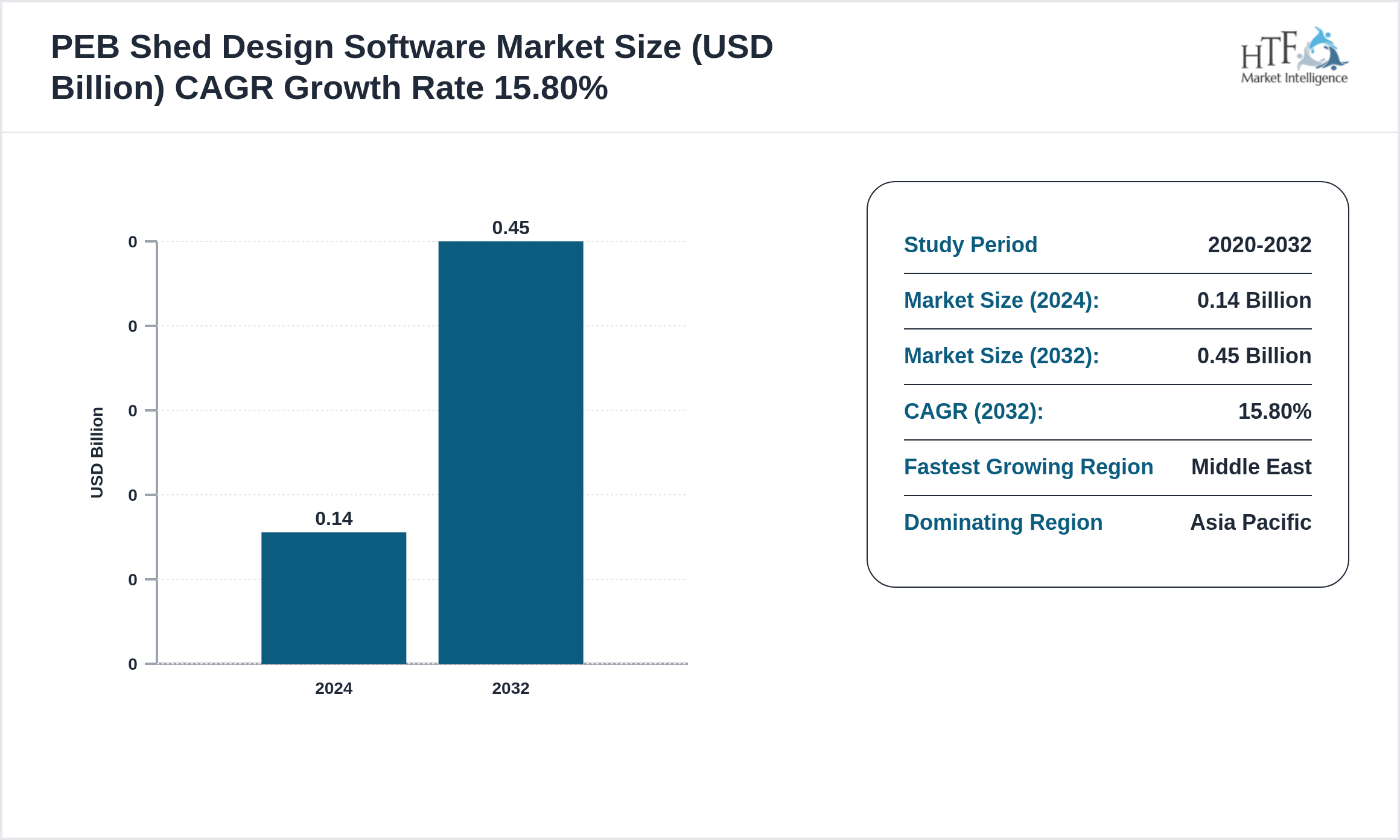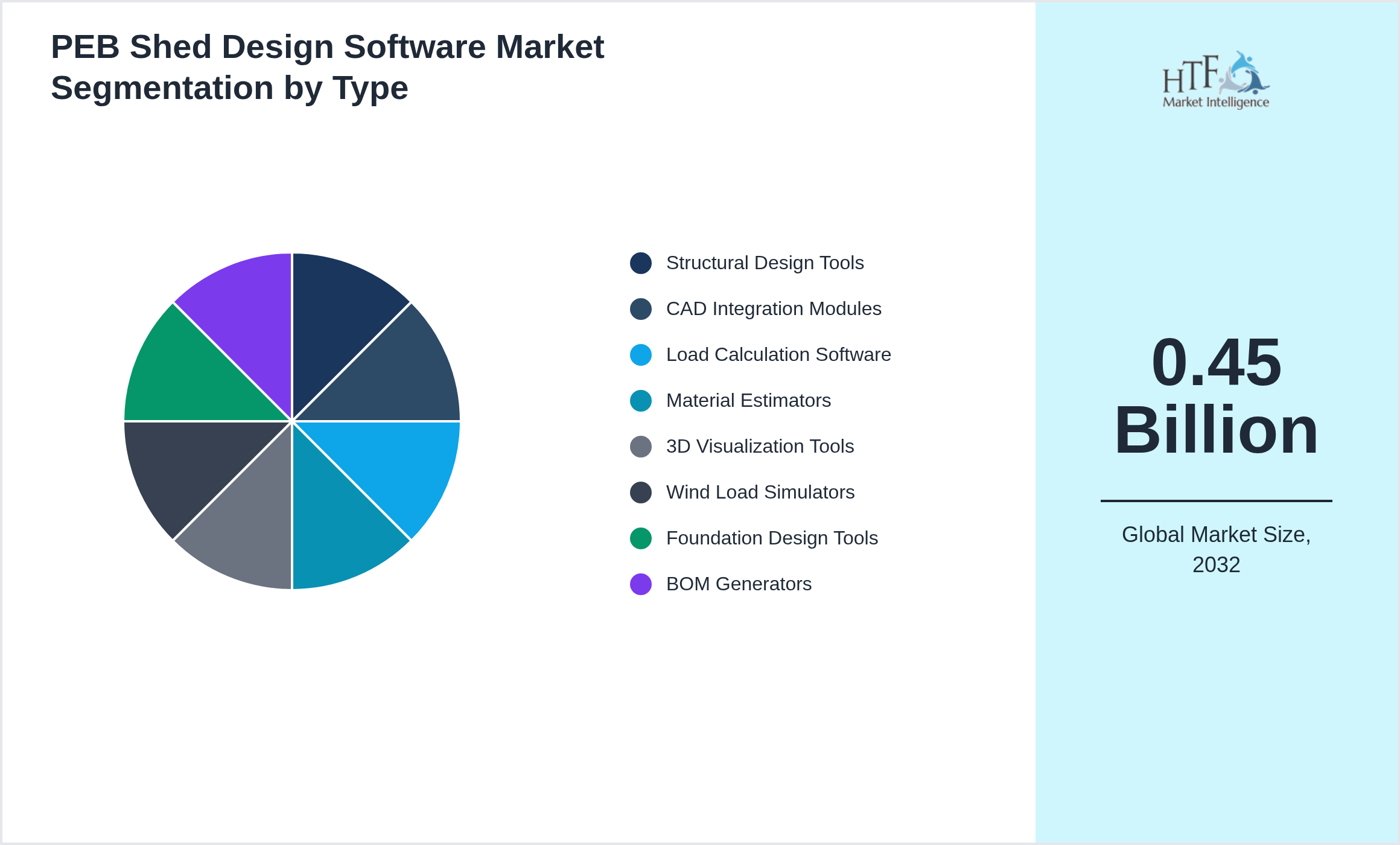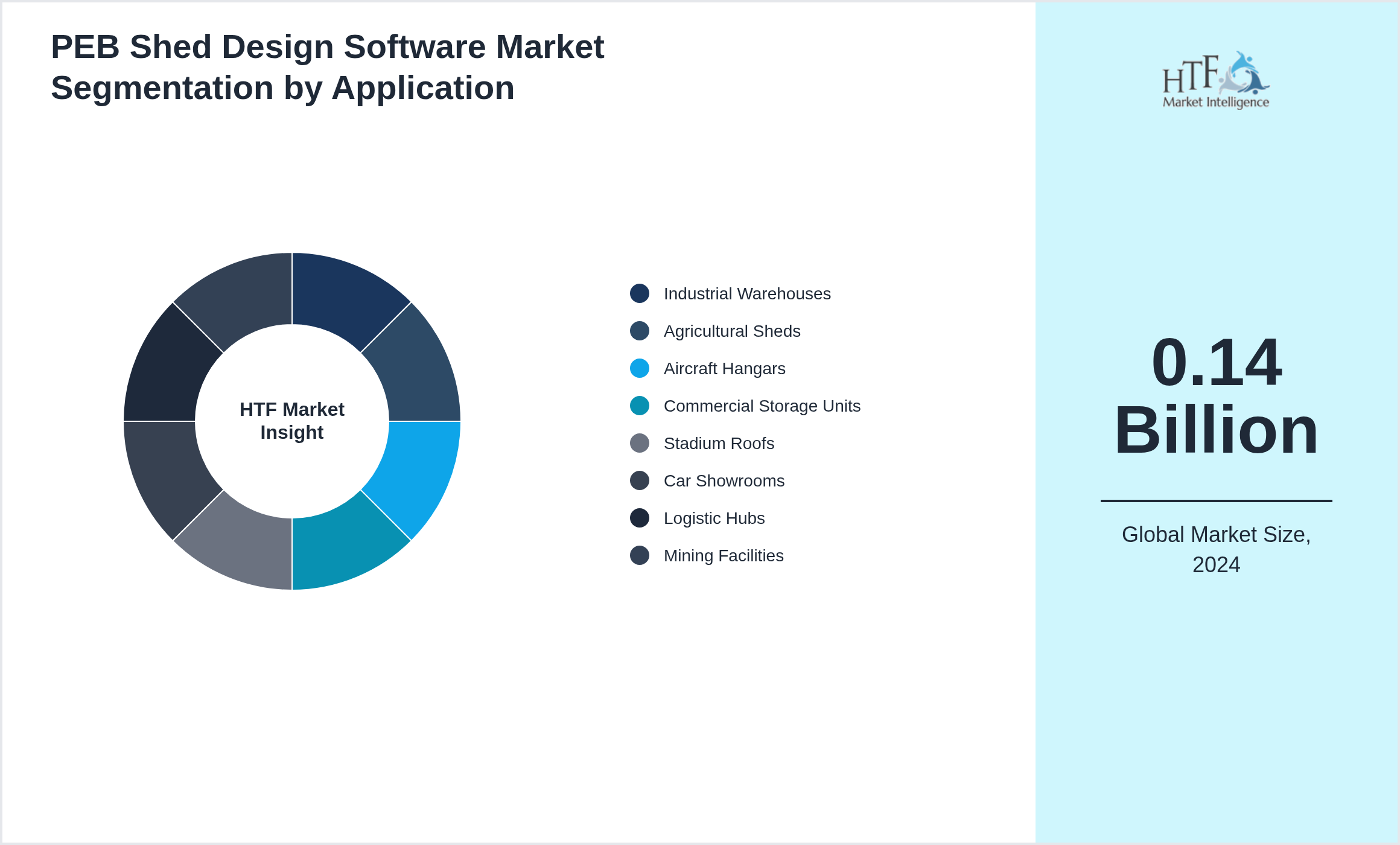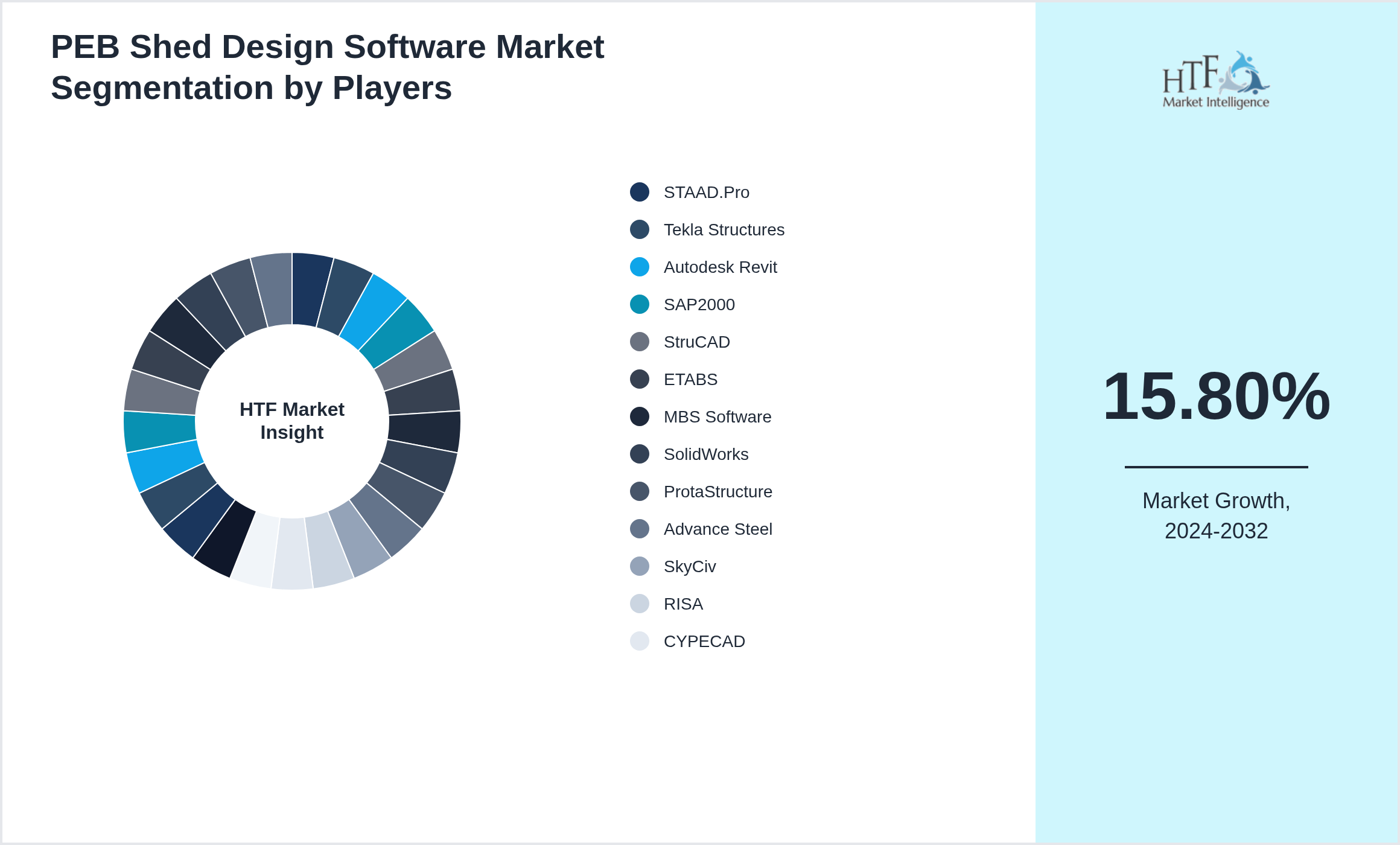PEB Shed Design Software Market Research Report
Global PEB Shed Design Software Market Scope & Changing Dynamics 2024-2032
Global PEB Shed Design Software Market is segmented by Application (Industrial Warehouses, Agricultural Sheds, Aircraft Hangars, Commercial Storage Units, Stadium Roofs, Car Showrooms, Logistic Hubs, Mining Facilities), Type (Structural Design Tools, CAD Integration Modules, Load Calculation Software, Material Estimators, 3D Visualization Tools, Wind Load Simulators, Foundation Design Tools, BOM Generators), and Geography (North America, LATAM, West Europe, Central & Eastern Europe, Northern Europe, Southern Europe, East Asia, Southeast Asia, South Asia, Central Asia, Oceania, MEA)
Pricing
INDUSTRY OVERVIEW
The PEB Shed Design Software market is experiencing robust growth, projected to achieve a compound annual growth rate CAGR of 15.80% during the forecast period. Valued at 0.14 Billion, the market is expected to reach 0.45 Billion by 2032, with a year-on-year growth rate of 6%. This upward trajectory is driven by factors such as evolving consumer preferences, technological advancements, and increased investment in innovation, positioning the market for significant expansion in the coming years. Companies should strategically focus on enhancing their offerings and exploring new market opportunities to capitalize on this growth potential.

PEB (Pre-Engineered Building) shed design software is a specialized tool used by architects, engineers, and contractors to design and optimize the structure and layout of pre-engineered buildings, particularly industrial sheds, warehouses, and large-scale storage facilities. This software allows for the creation of customizable steel structures, where the building framework, roofing, cladding, and foundations are prefabricated to minimize onsite construction time. Features include 3D modeling, load analysis, structural optimization, and energy efficiency evaluations. With the help of PEB shed design software, designers can consider factors such as wind load, seismic resistance, foundation requirements, and building codes for specific regions. As demand for cost-effective, scalable, and sustainable building solutions grows, PEB shed design software is playing a critical role in the construction industry, especially in logistics, agriculture, and manufacturing sectors. Integration with BIM (Building Information Modeling) and ERP systems allows for seamless project management and execution.
Regulatory Landscape
Regulatory Framework
The Information and Communications Technology (ICT) industry is primarily regulated by the Federal Communications Commission (FCC) in the United States, along with other national and international regulatory bodies. The FCC oversees the allocation of spectrum, ensures compliance with telecommunications laws, and fosters fair competition within the sector. It also establishes guidelines for data privacy, cybersecurity, and service accessibility, which are crucial for maintaining industry standards and protecting consumer interests.
Globally, various regulatory agencies, such as the European Telecommunications Standards Institute (ETSI) and the International Telecommunication Union (ITU), play significant roles in standardizing practices and facilitating international cooperation. These bodies work together to create a cohesive regulatory framework that addresses emerging technologies, cross-border data flow, and infrastructure development. Their regulations aim to ensure the ICT industry's growth is both innovative and compliant with global standards, promoting a secure and competitive market environment.
Key Highlights
• The PEB Shed Design Software is growing at a CAGR of 15.80% during the forecasted period of 2020 to 2032
• Year on Year growth for the market is 6%
• Based on type, the market is bifurcated into Structural Design Tools, CAD Integration Modules, Load Calculation Software, Material Estimators, 3D Visualization Tools, Wind Load Simulators, Foundation Design Tools, BOM Generators
• Based on application, the market is segmented into Industrial Warehouses, Agricultural Sheds, Aircraft Hangars, Commercial Storage Units, Stadium Roofs, Car Showrooms, Logistic Hubs, Mining Facilities
• Global Import Export in terms of K Tons, K Units, and Metric Tons will be provided if Applicable based on industry best practice
Market Segmentation Analysis
Segmentation by Type
- • Structural Design Tools
- • CAD Integration Modules
- • Load Calculation Software
- • Material Estimators
- • 3D Visualization Tools
- • Wind Load Simulators
- • Foundation Design Tools
- • BOM Generators

Segmentation by Application
- • Industrial Warehouses
- • Agricultural Sheds
- • Aircraft Hangars
- • Commercial Storage Units
- • Stadium Roofs
- • Car Showrooms
- • Logistic Hubs
- • Mining Facilities

Key Players
Several key players in the PEB Shed Design Software market are strategically focusing on expanding their operations in developing regions to capture a larger market share, particularly as the year-on-year growth rate for the market stands at 6%. The companies featured in this profile were selected based on insights from primary experts, evaluating their market penetration, product offerings, and geographical reach. By targeting emerging markets, these companies aim to leverage new opportunities, enhance their competitive advantage, and drive revenue growth. This approach not only aligns with their overall business objectives but also positions them to respond effectively to the evolving demands of consumers in these regions.
- • STAAD.Pro
- • Tekla Structures
- • Autodesk Revit
- • SAP2000
- • StruCAD
- • ETABS
- • MBS Software
- • SolidWorks
- • ProtaStructure
- • Advance Steel
- • SkyCiv
- • RISA
- • CYPECAD
- • SCIA Engineer
- • AutoCAD
- • Bocad
- • Rhino
- • IDEA StatiCa
- • Bentley Systems
- • FrameCAD
- • BuildSoft
- • S-FRAME
- • SmartBuild Systems
- • PEB Steel
- • Tekla Tedds

Research Methodology
At HTF Market Intelligence, we pride ourselves on delivering comprehensive market research that combines both secondary and primary methodologies. Our secondary research involves rigorous analysis of existing data sources, such as industry reports, market databases, and competitive landscapes, to provide a robust foundation of market knowledge. This is complemented by our primary research services, where we gather firsthand data through surveys, interviews, and focus groups tailored specifically to your business needs. By integrating these approaches, we offer a thorough understanding of market trends, consumer behavior, and competitive dynamics, enabling you to make well-informed strategic decisions. We would welcome the opportunity to discuss how our research expertise can support your business objectives.
Market Dynamics
Market dynamics refer to the forces that influence the supply and demand of products and services within a market. These forces include factors such as consumer preferences, technological advancements, regulatory changes, economic conditions, and competitive actions. Understanding market dynamics is crucial for businesses as it helps them anticipate changes, identify opportunities, and mitigate risks.
By analyzing market dynamics, companies can better understand market trends, predict potential shifts, and develop strategic responses. This analysis enables businesses to align their product offerings, pricing strategies, and marketing efforts with evolving market conditions, ultimately leading to more informed decision-making and a stronger competitive position in the marketplace.
Market Driver
- • Infrastructure growth
- • Steel structure preference
- • Time-saving needs
- • Construction cost control
- • Demand for modularity
- • Ease of installation
- • Industrial expansion
- • Urban storage needs
Market Trend
- • BIM integration
- • Cloud-based modeling
- • AR-assisted design reviews
- • Real-time collaboration
- • Parametric design features
- • Mobile app compatibility
- • AI load testing
- • Green building plugins
- • Regional construction codes
- • Steel supplier integrations
- • Government infrastructure schemes
- • OEM customization
- • Real estate boom
- • Educational institution use
- • IoT sensor planning
- • Prefabrication startups
Challenge
- • Compatibility with local codes
- • Training requirements
- • High licensing costs
- • Design complexity
- • Software update needs
- • Data backup concerns
- • User resistance
- • Limited offline use
Regional Outlook
The Asia Pacific Region holds the largest market share in 2024 and is expected to grow at a good CAGR. The Middle East Region is the fastest-growing region due to increasing development and disposable income.
North America remains a leader, driven by innovation hubs like Silicon Valley and a strong demand for advanced technologies such as AI and cloud computing. Europe is characterized by robust regulatory frameworks and significant investments in digital transformation across sectors. Asia-Pacific is experiencing rapid growth, led by major markets like China and India, where increasing digital adoption and governmental initiatives are propelling ICT advancements.
The Middle East and Africa are witnessing steady expansion, driven by infrastructure development and growing internet penetration. Latin America and South America present emerging opportunities, with rising investments in digital infrastructure, though challenges like economic instability can impact growth. These regional differences highlight the need for tailored strategies in the global ICT market.
- North America
- LATAM
- West Europe
- Central & Eastern Europe
- Northern Europe
- Southern Europe
- East Asia
- Southeast Asia
- South Asia
- Central Asia
- Oceania
- MEA
|
Report Features |
Details |
|
Base Year |
2024 |
|
Based Year Market Size (2024) |
0.14 Billion |
|
Historical Period Market Size (2020) |
USD Million ZZ |
|
CAGR (2024 to 2032) |
15.80% |
|
Forecast Period |
2025 to 2032 |
|
Forecasted Period Market Size (2032) |
0.45 Billion |
|
Scope of the Report |
Structural Design Tools, CAD Integration Modules, Load Calculation Software, Material Estimators, 3D Visualization Tools, Wind Load Simulators, Foundation Design Tools, BOM Generators, Industrial Warehouses, Agricultural Sheds, Aircraft Hangars, Commercial Storage Units, Stadium Roofs, Car Showrooms, Logistic Hubs, Mining Facilities |
|
Regions Covered |
North America, Europe, Asia Pacific, South America, and MEA |
|
Year on Year Growth |
6% |
|
Companies Covered |
STAAD.Pro, Tekla Structures, Autodesk Revit, SAP2000, StruCAD, ETABS, MBS Software, SolidWorks, ProtaStructure, Advance Steel, SkyCiv, RISA, CYPECAD, SCIA Engineer, AutoCAD, Bocad, Rhino, IDEA StatiCa, Bentley Systems, FrameCAD, BuildSoft, S-FRAME, SmartBuild Systems, PEB Steel, Tekla Tedds |
|
Customization Scope |
15% Free Customization (For EG) |
|
Delivery Format |
PDF and Excel through Email |
PEB Shed Design Software - Table of Contents
Chapter 1: Market Preface
Chapter 2: Strategic Overview
Chapter 3: Global PEB Shed Design Software Market Business Environment & Changing Dynamics
Chapter 4: Global PEB Shed Design Software Industry Factors Assessment
Chapter 5: PEB Shed Design Software : Competition Benchmarking & Performance Evaluation
Chapter 6: Global PEB Shed Design Software Market: Company Profiles
Chapter 7: Global PEB Shed Design Software by Type & Application (2020-2032)
Chapter 8: North America PEB Shed Design Software Market Breakdown by Country, Type & Application
Chapter 9: Europe PEB Shed Design Software Market Breakdown by Country, Type & Application
Chapter 10: Asia Pacific PEB Shed Design Software Market Breakdown by Country, Type & Application
Chapter 11: Latin America PEB Shed Design Software Market Breakdown by Country, Type & Application
Chapter 12: Middle East & Africa PEB Shed Design Software Market Breakdown by Country, Type & Application
Chapter 13: Research Finding and Conclusion
Frequently Asked Questions (FAQ):
The Compact Track Loaders market is expected to see value worth 5.3 Billion in 2025.
North America currently leads the market with approximately 45% market share, followed by Europe at 28% and Asia-Pacific at 22%. The remaining regions account for 5% of the global market.
Key growth drivers include increasing construction activities, rising demand for versatile equipment in agriculture, technological advancements in track loader design, and growing preference for compact equipment in urban construction projects.
